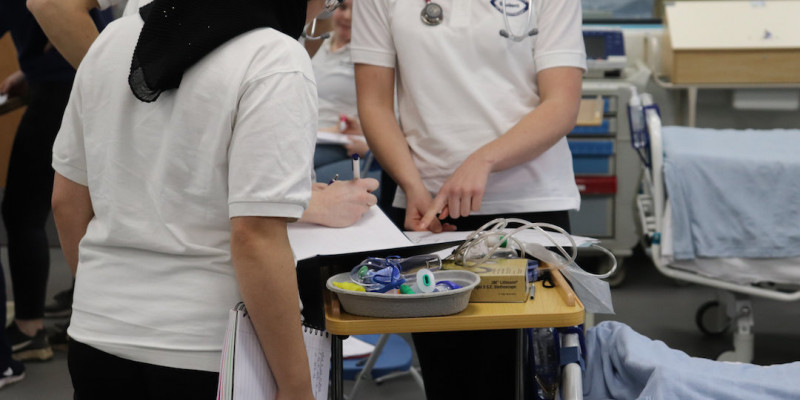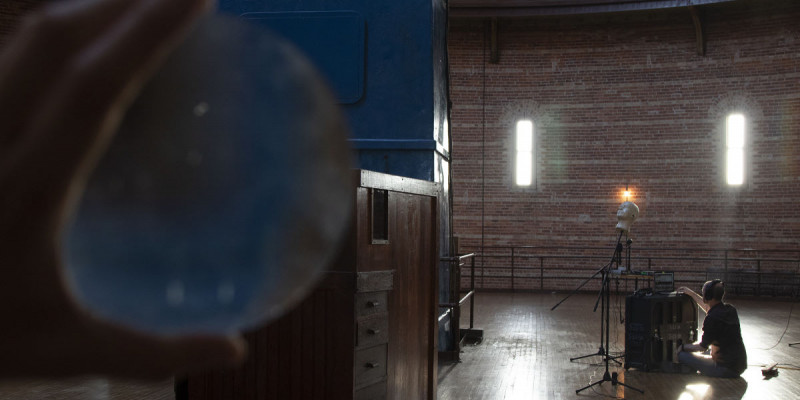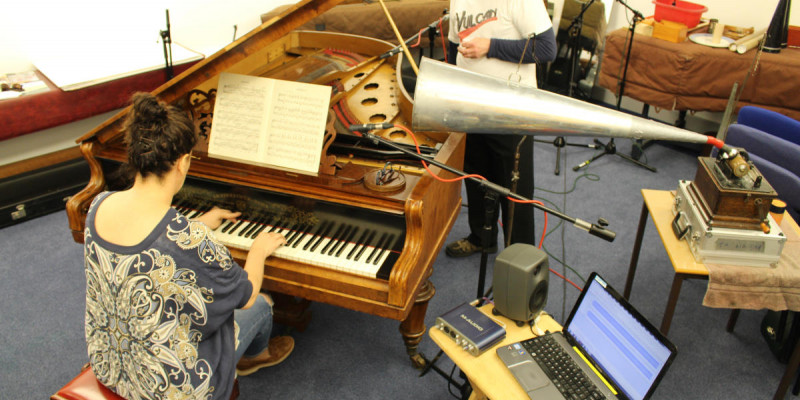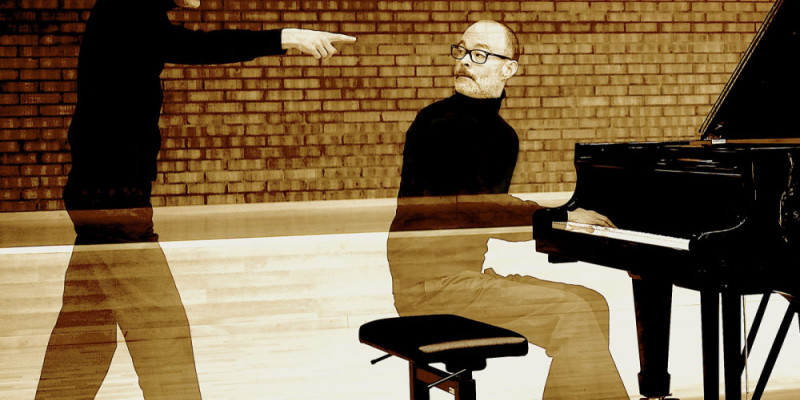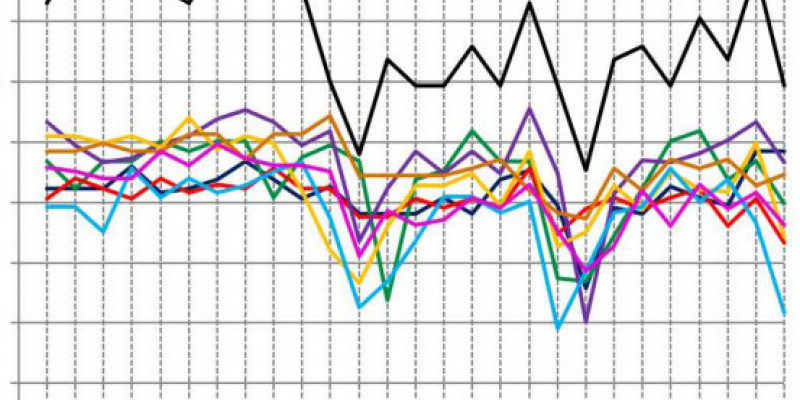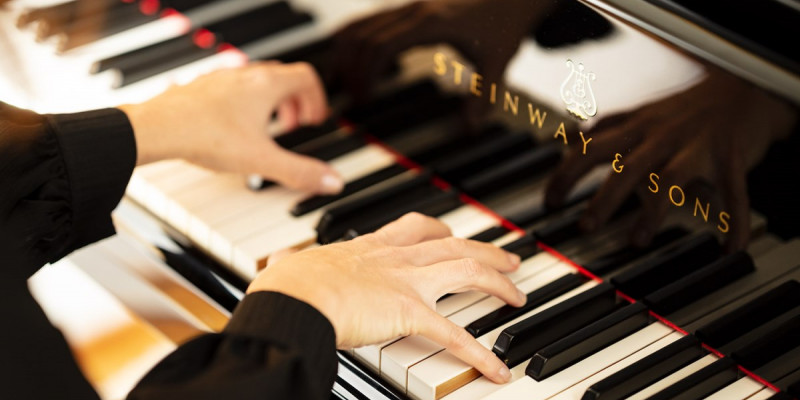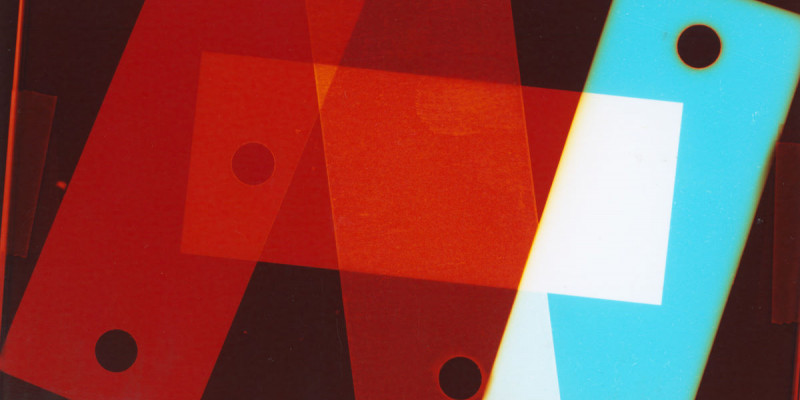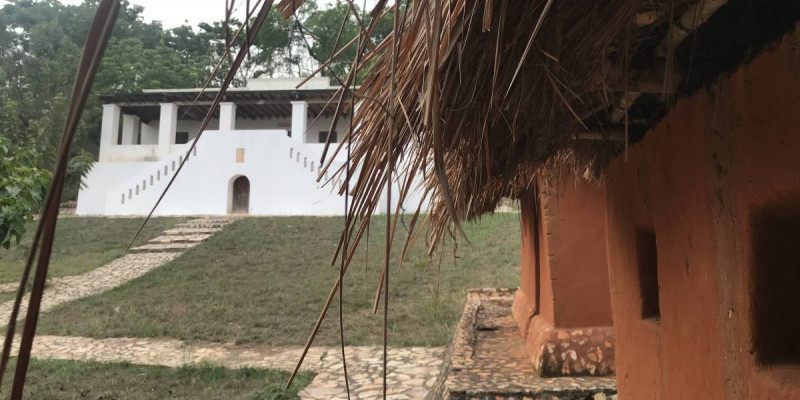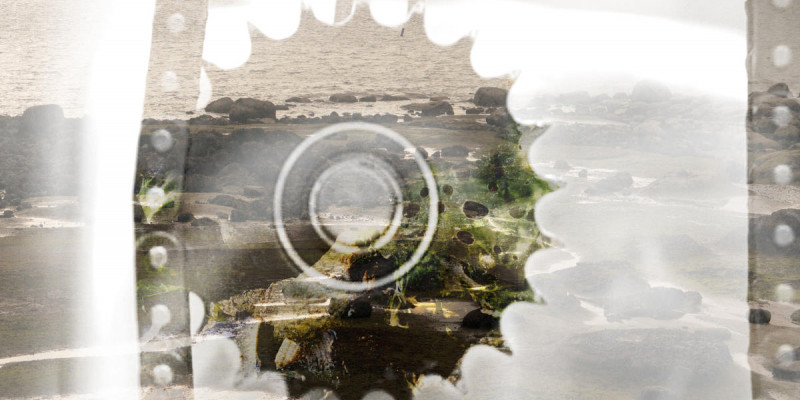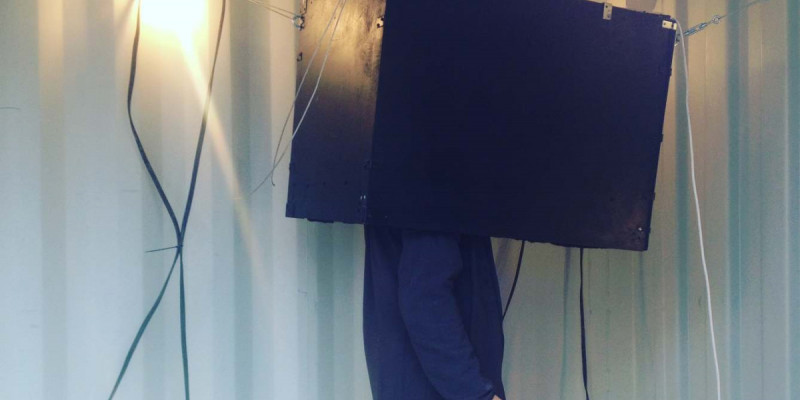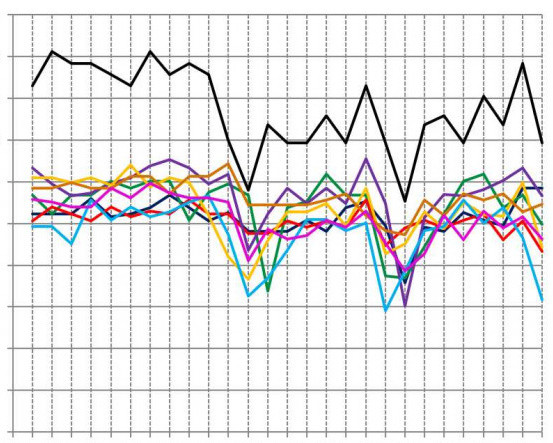
Seismograms of a musical work
Abstract
This paper aims to posit performers and performance (within the Western Art Music tradition) as a source of knowledge in a reconsideration of the musical work’s ontology. I argue that performance, when involving precomposed pieces, cannot be fully understood without an acknowledgement of a “relationship” between performer and work, and vice versa—that the work cannot be properly understood without serious consideration of performances.
To this end, I suggest a model for the performance-work relationship that is analogous to Johann Gottlieb Fichte’s model for self-consciousness. This model of the musical work emphasises the absolute interdependence of the performance and the work.
In the main portion of the article I analyse recordings by twentieth- and twenty-first-century pianists, focusing on four excerpts from music by Johann Sebastian Bach and Frederic Chopin. I use tempo graphs, generated through Sonic Visualiser software, to explore how the interdependent relationship between the performer/performance and the work plays out in concrete, sounding performances. A comparison of the tempo graphs of a piece performed by different pianists shows that it is precisely at moments determined by the score that there is the most individuality between performances, as well as fluctuation from a constant tempo within a performance.
Introduction1
Even though I have set ideas, things I want to try to show in the music are not actually on the surface of it. I can show it with a diminuendo; I can show it with a crescendo. …the point is, let’s say I’m showing a dissonant chord resolving in a phrase. I’ll decide at the last minute how it’s going to go. Murray Perahia (Duffie 1997)
What a paradoxical and touching ambition, stamped as much with boldness as with humility! What burning desire for submission… What a stirring vision, inspiring us to see in the movement of a great work of art some echo of our own aspirations, and seducing us, at times in such a wonderful way, into the belief that the soul of the composer might truly abide in ours. Alfred Cortot (Gavoty 1955, p. 27)
This paper is an exploration of the relationship between musical works and performances, in music of the Western Art tradition. I aim to shed light on one aspect of the musical work, through focusing on the phenomenon of the performance. A focus on performance and on empirical detail is yet to be combined with a more theoretical consideration of the musical work, which is what this paper aims to do: to take empirical observation—analysis of recordings, with tempo measurements made using Sonic Visualiser software—as a basis to reflect on the ontology of musical works.
The musical work, in both musicological and everyday locutions, has often been associated more with the composer than with the performer, and more with the score than with its sonic realisation.2 This despite the existence of theories according to which works are sound structures, or are types whose tokens are performances, and despite efforts in scholarship to include the notion of the performative in the discourse to a greater extent than hitherto (Cook 1999; Parmer 2014).3 My approach embraces Dillon Parmer’s idea that “the musical work is the work performers undertake to give birth to music in actual practice” (Parmer 2007, p. 11), or, as Hans-Georg Gadamer put it, “the work itself is what ‘takes place’ in the performative event” (Gadamer, cited in Frisk and Östersjö 2006). The process of performing is, as I will argue, a crucial part of the work’s potentially endless “life-cycle”, and much can be learnt about the ontological status of the work by reflecting on what is involved in the act of performance. I wish to engage with the phenomenon of the work in the present tense: its mode of being during its sonic realisation.
The accounts of the musical work by writers such as Jean-Jacques Nattiez (1990), Parmer (2007), and Henrik Frisk and Stefan Östersjö (2006) include the dimension of the work’s relationship with the performer or performance. My analysis similarly places the performer and performance directly within the musical work’s ontology. But I also attempt to consider the “relationship” felt by the performer between themselves and the work, in live acoustic performances of works, and to posit performance more radically as the source of knowledge, with a significant emphasis on empirical observation.4 I will analyse the multiple tempo graphs (each looking like a squiggle) that arise from the multiple performances of the same musical work, and discuss the ways in which they reflect the status of musical works. Not only does each “squiggle”, corresponding to an individual performance, differ from its counterparts in shape, but there is also an agreement or consensus as to where in the score they significantly diverge from one another.
An acknowledgement and consideration of the notion and effects of the musical work is indispensable if we are to properly understand how performance operates for pianists performing precomposed pieces. From writers who have pointed out the historical and cultural contingency of the work-concept, we learn to be conscious of the fact that certain aspects of what we call works are only meaningfully talked about in specific contexts. But within those contexts, the work is powerful. As Michael Talbot (ed. 2000, p. 12) writes, the musical work is, “in the most literal sense, an invented reality” (emphasis in original). And if classical music’s status as high-brow art seems to have placed musical works in an imaginary museum (Goehr 1992), for some musicians such as myself, the excitement of picking new repertoire, discovering and “getting to know” new pieces is comparable to the excitement of a child in a candy store. The delicious sweets can be touched, looked at, talked about, exchanged—but the true experience of the sweet only comes at the moment it melts on the tongue.
Existing theories of the work-performance relationship
According to Nicholas Cook (2014, p. 98), “the traditional approach to performance” within the Western Art Music tradition is based on the idea that “the already existing work is to be accurately transmitted through performance to the listener” (my emphasis); he is of course challenging this assumption. This “traditional approach” would concur with most analytic views of the work which ascribe an existence to the work independently of any specific performances of it. It also seems to resonate with Jean-Jacques Nattiez’s model of the “total musical fact”. His theory of musical semiology involves three “semiological levels”: the poietic (involving creation), the neutral (relating to the created product), and the esthesic (interpretative) levels (Nattiez 1990, pp. x-xi). The work, arising in the poietic phase, is transmitted intact as a sounding structure (the neutral level) to the listener, waiting on the esthesic end. It goes without saying that such an account would be a gross reduction of the complex interplay of processes involved in the total fact, and Nattiez is of course aware of this. “[S]ince music is an art of ‘interpretation,’ ” he writes, “where does the poietic process end and the esthesic process begin?” (p. 72). (For Nattiez, the meaning of the term “interpretation” includes both performing works and audiences/critics interpreting verbally.)
If we conceive of the work as an entity comprised of relations that are fixed by the score, …the esthesic process begins at the instant the performer interprets the work, in both senses of the word…
If on the other hand we believe that the work is not wholly “produced” unless it has been played, the poietic process extends until the performance is complete. Performance shows itself in this case to be the last stage of the poietic, as well as the first stage of the esthesic (p. 72).
Nattiez’s view tends towards what is expressed in the first of the two paragraphs quoted here, because he is invested in the notion of a neutral level—the score—between composition and performance. Still, the chaotic coexistence and criss-crossing of the three levels is an important aspect of Nattiez’s total musical fact. His illustration of the processes involved in a performance of Wagner’s Ring shows that the acts of the composer, the conductor and director, and the spectators and critics, each involve all three levels, beginning with Schopenhauer’s influence on Wagner, Wagner’s creation of the work, the score produced by him, the interpretation of this score by the performers, their performance of the work, the phenomenon of this performance, interpreted in turn by the audience, and so on (pp. 74-77).
But this, it seems, is more a conglomerate of broken-down musical processes, rather than an integrated picture of a “total fact”, and I do not think that the act of physically performing a work is felt by the performer, for instance, as merely the sum of three heterogeneous processes. Likewise, a listener’s acts of hearing the music and reacting to it cannot be neatly separated.
The three levels could be better described as being in an interdependent and immediate relationship with each other. Henrik Frisk and Stefan Östersjö (2006) point out that both the acts of performance and of composition involve a mixture of poietic and esthesic processes: the artist alternates between creating and listening.5 This is comparable to Dillon Parmer’s (2007) description of the reciprocal relationship between the artist’s “sound-image” and his or her realisation thereof (either in the form of a score or a sounding performance). In this relationship, “each produces the other so that the realization of an idea into material form alters or conditions the idea that simultaneously gives rise to the realization” (p. 35). In these models, the musical work arises as a product of both creative and interpretative processes.
Within this model of the performer alternating between creative and receptive acts, I now wish to give a more significant role to the “agency” of the music, and the predeterminedness of the musical work. Pianists’ thoughts expressed in interviews, biographies and letters show that the music is felt to have a potency which makes pianists talk about works as though they are entities with agency: works “demand” commitment. Maurizio Pollini talks of his “relationship with Chopin” (Finane n.d.). Artur Schnabel, according to Claudio Arrau, was “servant of the music” (Horowitz 1982, p. 113), and a “faithful interpreter”. (Also see Alfred Cortot’s very Romantic formulation of the artist’s ambition in the epigraph.) And as writers such as Jerrold Levinson (2015) and John Butt (2015) have shown, through different approaches, the “relationship” or “interaction” between people and the music is a crucial element when discussing the work-concept.
Fichte’s model of the I as an analogy for the performed work
I will suggest a model for the performance-work relationship that is analogous to the idealist philosopher Johann Gottlieb Fichte’s model of self-consciousness. Fichte (1994) distinguishes two types of objects of consciousness, or “representations” (things about which we think or of which we are conscious). One of these types
[appears] to us to depend entirely upon our own freedom, and it is impossible for us to believe that anything outside of us, i.e. something that exists independently of our own efforts, corresponds to representations of this sort. Our imagination and our will appear to us to be free (p. 7).
The second type involves
a truth that is supposed to be firmly established independently of us… When a representation of ours is supposed to correspond to this truth, we discover that we are constrained in determining this representation… In short, we could say that some of our representations are accompanied by a feeling of freedom and others are accompanied by a feeling of necessity (pp. 7-8).
The former type “gives us a purely ‘made up’ or invented object” while the latter “furnishes us with an object of experience” (p. 12). But there is a third type of representation, according to Fichte—the most interesting one, in a way. This involves “the I”: the phenomenon of self-consciousness.
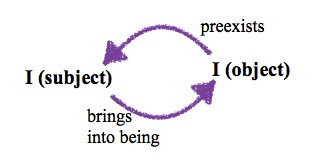
Fichte describes self-consciousness as the circular relationship between the “I” as subject and the “I” as object, in which I (subject) see or think about myself (object). Here, freedom (of thinking about myself) is coexistent with a sense of predetermination and necessity (in which I appear to myself). There is an inherent tension here. In observing myself I am actively creating myself as an object of consciousness; thus it would seem as though the observing “I” ontologically precedes the “I” as object. Yet I cannot see myself unless the object exists in the first place (Fig. 1). “I am…an object for myself, an object whose properties, under certain conditions, depend upon the intellect alone, but whose existence must always be presupposed” (p. 13). Fichte points out that there is an “immediate unity of being and seeing”:
if I may speak figuratively, there is a double series within the intellect: a series of being and a series of observing, a series of what is real and a series of what is ideal. The essence of the intellect consists precisely in the indivisibility of this double series” (p. 21, my emphasis).
One side cannot exist without the other in this two-fold model of self-consciousness.6
By analogy, the performance actively instantiates, realises, brings into being, and in that sense creates, the work. The performer, a human subjectivity, mixes into the sound of the work their own particular style, emotions, experiences, understanding. Yet there cannot be such a performance unless a potentiality for the work exists in the first place: the latter’s “existence must be presupposed”. The respective existences of the performance and the work are thus mutually dependent. It is not merely a reciprocal relationship in which the two affect or are advantageous for each other, but there is (to use Fichte’s expression) a fundamental indivisibility to this double series. As my analysis of recordings will show, each performance makes the work into a sounding event, and in doing so determines how the work sounds; but at the same time the interpretative decisions made by the performer are determined by how the work would, could or should sound. Thus arises the phenomenon, for instance, of what I will call “antinodes”—a point of divergence in tempo between performances—which is a product of decision-making plus predeterminedness. While there is a freedom and activeness in the act of performing the work, the work is fixed in certain important aspects, and thus places a constraint on the way in which it can be performed.
There is, in addition, an uncanny resemblance between Fichte’s characterisation of self-consciousness and the composer’s act of notating the work, when composition involves a feeling of “discovering”. The work only comes into existence because the composer actively writes it, but the work may seem like a predetermined entity discovered by the composer, perhaps within themselves or from without—they might “hear” it. Of course, this description will not apply to every compositional experience. But it is a possible experience; and it means that the crucial difference here between the composer-work cycle (which results in the score) and the performance-work cycle is that while the former happens just once, the latter can happen any number of times with a single work.
Where, then, do the composer’s and listener’s acts fit into the model of the performance-work cycle? They rather fit around it: the composer’s product—usually the score—is what is needed in the first place for the performer to be able to kick off the cycle (the poietic). The listener witnesses this cycling (the esthesic) (Fig. 2).7 This is the distinctness of making sounding music from listening, or witnessing the making.8
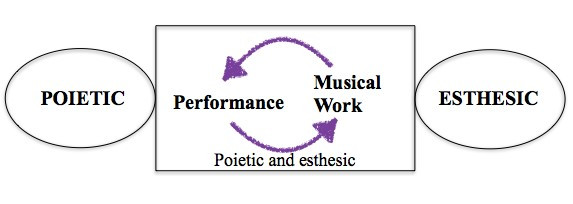
Moreover, the performer’s awareness of the listener’s presence also helps fuel the cycle, in such cases as described by the pianist Murray Perahia in an interview with Bruce Duffie (1997):
MP [Murray Perahia]: …There’s an excitement that goes into a live concert that’s very hard to capture in a recording. Sometimes it works; sometimes it goes. It’s not to say that it’s impossible, but I do find that it’s different to play for an audience.
BD [Bruce Duffie]: Are you aware of them sitting on your right?
MP: Yes, you are. You’re aware of singing the song to somebody, and that makes a different experience than just playing it in a room for the microphone.
The performance-work cycle, flanked on either side by the composer’s poietic process and the audience’s esthesic process, now corresponds, in terms of its positioning, to Nattiez’s “neutral” level—which itself involves both poietic and esthesic processes, and in fact turns out to be a dynamic process dependent on the performer’s artistic commitment to the work.
It is debatable to what extent the audience’s presence (and hence the “esthesic” bubble in Fig. 2) is an essential part of the performance of a work. On the one hand, it would not seem to be necessary in the way the composer’s poietic work is, as musical works can be performed in practice rooms and recording studios, with no audience present. Arguably, the audience is at least imagined in such circumstances: the acts of practising and recording works are aimed towards presupposed and/or future audiences, as well as towards the performer’s listening self. The actual bodily presence of an audience is thus not a necessary ingredient in the act of performing a work, though as Perahia describes, when present, it helps positively fuel the coming-into-being of the work. On the other hand, when the work is being heard through a recording, the listener’s experience is that the work is coming into being as they listen (rather than as the performer actually plays), and thus the esthesic does indeed become an essential part of the work’s existence.9
The reciprocal dependence between the work and the performance involved in the cyclic model implies two things: firstly, the unknowability of the ontological precedence of either the work or the performance, and secondly that one side cannot exist without the other. What does this all look like, though, in actual sounding performances of works? The model in Fig. 2 emphasises above all the relationship of absolute interdependence between the performance and the work. In what follows, I explore in what concrete ways such a relation plays out and manifests itself in multiple performances of the same works.
Methodology
The focus of my observations is narrow: I survey recordings10 of twentieth- and twenty-first-century classical pianists, and my analysis focuses primarily on tempo fluctuation.11 The recordings I examine are of four short excerpts from pieces by Johann Sebastian Bach and Frederic Chopin—two by each composer—centered around moments where the main theme appears (not necessarily for the first time in the piece) after introductory or non-thematic material. Formally, these are significant points in the structure of each piece. I focus on how these “moments of appearance” are treated in performances—specifically, whether they are emphasised, and if so, in what ways. Is there a sense of necessity, predetermination or constriction imposed by the work when it comes to interpretative decisions? (How) does the work allow for a performer’s individuality? What does it in fact mean for a moment in the work to be structurally significant—what is the role of the performance in relation to the work at such a moment?
I have selected Bach and Chopin for a number of reasons. They are performed often, which could suggest that there are as many different ways of interpreting their music; or, on the other hand, the fact that it is heard so often could result in pianists having difficulty escaping an established manner of playing. Furthermore, the music of Bach and that of Chopin are associated with differing performance styles. In traditional conceptions of appropriate Chopin performance, rubato is a sine qua non, whereas Bach’s music (especially in “mainstream” performance) is often associated with greater metrical strictness, or at least a different kind of rhythmic flexibility from the sweeping rubato we apply to Romantic music. Surveying these two composers would offer a wide ambit of performance styles.
While my focus is on tempo fluctuation, this is, of course, only one of the many expressive dimensions involved in piano performance: others include dynamics, timbre, pedaling, articulation. These are all utilised by pianists to create certain characters, moods and other expressive qualities. I have chosen duration as it is the most accurately measurable dimension and allows comparison between recordings of variable sound quality.
I analyse a boundary area in each piece, where there is no break in the flow of notes, and thus where one moment—one cadence—is both an ending of a passage and a beginning of a theme. Philip Bohlman (2012) has shown that boundaries are fertile areas for philosophical exploration. Writing that borders “are among the most ontologically complex spaces, in music no less than in life” (p. 133), Bohlman relates the idea of boundaries to aporia—a logical threshold that cannot be crossed or resolved. He describes
aporia at borders functioning in three ways, drawing upon Jacques Derrida’s writings on aporia and death…: 1) the first function of aporia is that of a line that separates, hence must be crossed; 2) aporia can represent a zone of difference, of overlapping, of fullness; and 3) aporia can describe an area of impossibility and unknowability, of silence and emptiness (pp. 135-136).
Aporia, an incompatibility that creates two sides, might be applied to boundary areas in musical works. In the examples I have chosen, there is a distinction between the identities of non-thematic and thematic material, which creates a border at the very moment a theme enters after an introductory or connecting passage. Analytically, they are distinct sections with distinct functions and are thus conceptualised as separate entities, yet in the actuality of a performance that takes up time, the boundary between them is crossed, just as Henri Bergson’s Achilles overtakes the tortoise “in one stroke” (Bergson 2014).
By using such moments as starting points for analysing tempo fluctuation, I explore the connections between the score, the music, and the performance. Points of thematic arrival could be treated in more than one way: they can be, for example, slowed down into, or cause the tempo to drop in the aftermath, or do both, or (of course!) neither. My key question is: in what ways are the constrictions of the score and the performer’s freedom evident in the performance of a work?
I have selected the following “moments of arrival”:
Bach:
Prelude in F minor from The Well-Tempered Clavier Book I, BWV 857, second half of bar 16;
Italian Concerto BWV 971, first movement, bar 163.
Chopin:
Polonaise in A flat major, Op. 53 “Heroic”, bar 17;
Waltz in D flat major, Op. 64 No. 1 “Minute”, bar 5.
All these examples lack specific indications in the score dictating tempo changes (such as rit. followed by a tempo). The score of the Polonaise, however, has dynamic markings centered around the point of arrival: crescendo over the two bars immediately before the entry of the theme, forte on the downbeat of the entry, and then a short (one-beat) hairpin diminuendo. In each excerpt, I examine the bars surrounding the appearance of the theme in order to show how pianists handle both the lead-up and aftermath of the event. I have intentionally included performances from a wide range of decades from the twentieth and twenty-first centuries, as well as (for the Bach examples) harpsichord performances and one recording by Keith Jarrett, a musician well known as a jazz pianist and composer.
Measurements were made by me punching beats into Sonic Visualiser by tapping a computer key in time with each recording. The “positions” of the beats I entered (which were never precise after tapping along) were then manually adjusted to exactly fit the timings of the recordings. The graphs show the tempo in beats per minute since the previous beat, so that if there is a slowing-down or broadening within a beat, the graph will have a downward slope to the next beat; a rising slope represents a quickening of tempo within the beat (this is also why the values only begin from the second beat of each example—there is no “previous beat” for the first one). Where there is dislocation between the hands, I have taken the right-hand note as the beat, since it is the melody to which the ear is drawn more strongly (in all these examples the melody is in the right hand).
Analysis
Bach, Prelude in F minor, BWV 857
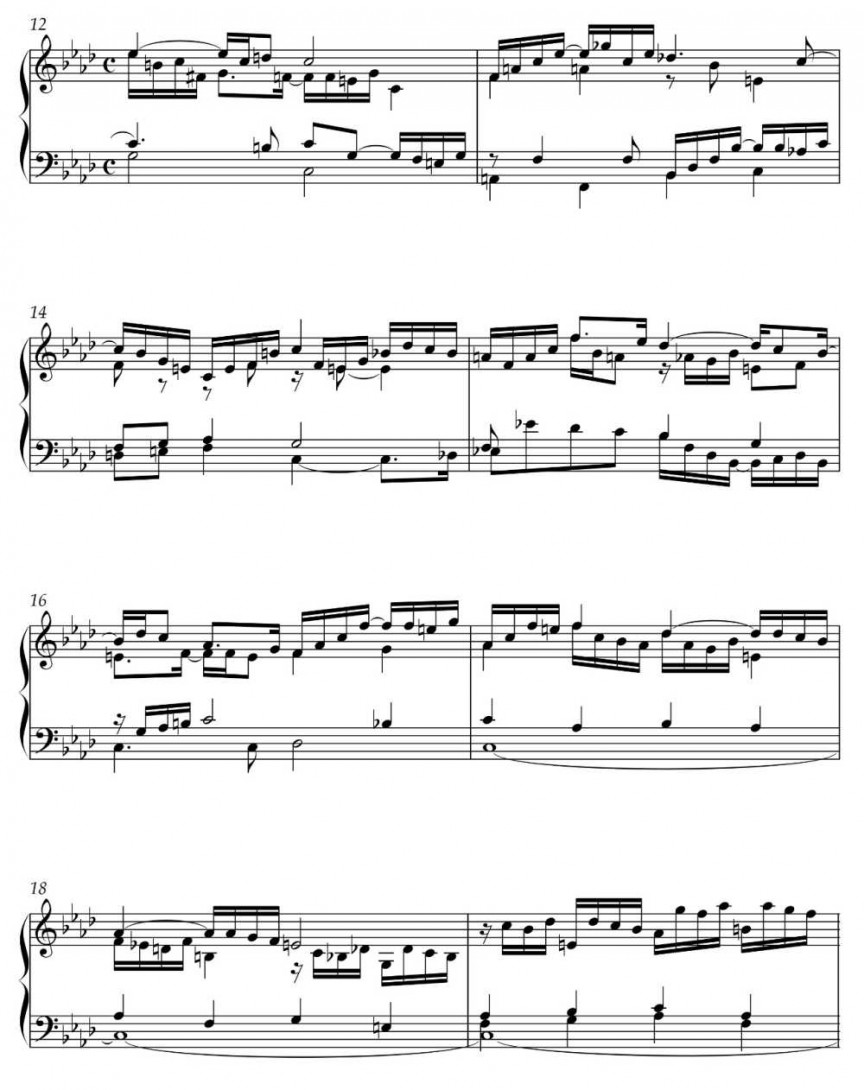
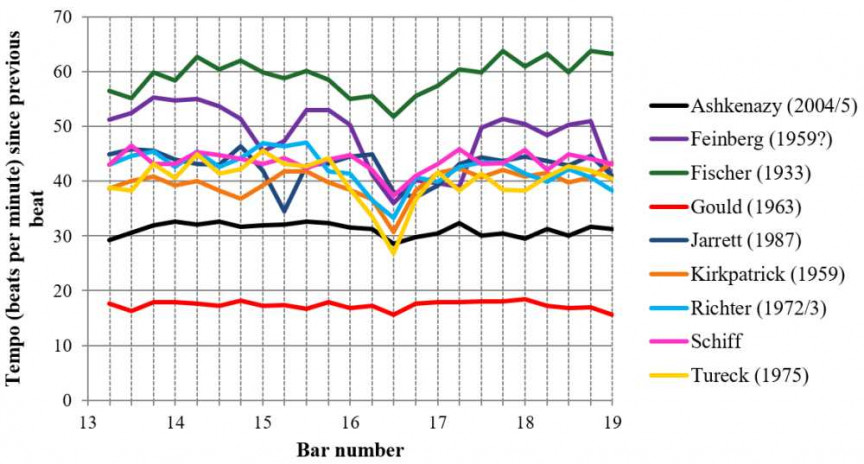
In this example, the moment of arrival, on the third crotchet beat of bar 16, involves a deceptive cadence in F minor over which the opening theme returns (this theme does not return at any other point in the Prelude). Fig. 3 shows the tempo for every crotchet beat.12
At a glance, there is one point where every single performance slows down: the lead-up to the theme’s arrival in mid-bar 16 and its immediate aftermath. The trough in the squiggles at that beat represents a slowing-down in all performances until the beat of the arrival, and a regaining of speed from that same beat—or the beat following the arrival, in Jarrett’s case.
Coexistent with this consensus regarding the location for slowing down, though, is a notable divergence between performances in the rate and degree of slowing down—in other words there is a significant variety in the shapes of the dip at this very spot. Tureck’s and Feinberg’s troughs drop deepest, whereas Gould’s subtle dip is more like a nuance. (Of course, the combination of the tempo drop with other expressive dimensions can result in a different effect from what the numbers would suggest on their own—coupled with a sudden change of dynamics, colour or articulation, a small ritenuto could make as much of an impression as a more exaggerated one with no dynamic change.) Something that is not represented in the graph is the fact that Tureck clearly is using inflections in the tempo to bring out the difference in the two voices in the right hand (she hesitates before entries in the upper voice) from the second half of bar 15 to the first half of bar 16, hence the comparatively significant dip in tempo.
In addition to the degree of the tempo drop, there is variety among performances as to the span of music involved in the slowing down: where the ritardando or ritenuto starts and where the accelerando or a tempo happens. In the performances of Tureck and Feinberg, there is a ritardando beginning on the last crotchet beat of bar 15 which continues through the first half of bar 16 while Schiff’s begins in bar 16; the slowing-down in the performances of Kirkpatrick, Fischer and Richter is even longer, whereas Gould, Jarrett and Ashkenazy pull back only during the second crotchet beat of bar 16. By the beginning of the fourth crotchet of bar 16 (i.e. during the third crotchet), all performances are back to a faster tempo except Jarrett, who emphasises the arrival through pulling back the tempo more in the aftermath than in the lead-up. The meaning, or character, of the lead-up and appearance also differs from performance to performance. In Richter’s rendition, after a dwindling of speed and volume into mid-bar 16, the theme begins immediately back in tempo, bringing with it a sense of renewed life. Schiff’s entry of the theme, after a hesitation subtler than most other performances, suddenly shifts into a softer, more mysterious world. Jarrett revels in the now-ness of the returned theme itself, not wanting to let go of the first two semiquavers in the third and fourth beats of bar 16 for as long as possible.
There are two performances that dip significantly at another point in addition to the cadence into the return of the theme: those of Jarrett and Feinberg, during the first beat of bar 15, where they both relax the tempo into the downbeat and then linger on the first semiquaver. Wolfgang Sandner’s liner notes accompanying Jarrett’s CD (1988) are intriguing and potentially illuminating. He describes Jarrett’s interpretations of Bach as “emphasizing nothing, demanding nothing, concealing nothing and withholding nothing. In one word: natural—that is, following the inherent laws of the works…” (Sandner 1988). At this particular downbeat of bar 15, Jarrett’s performance underlines the somewhat unexpected progression from the dominant of F minor to the F chord which has itself turned into the dominant seventh of B flat: the A natural in the top line and the E flat in the bass come as a surprise. He is, pace Sandner, emphasising that moment, but that is less the point. The point is that his pulling back of tempo is grounded in the harmonic events—“the inherent laws of the work.” The same can be said of Feinberg. It is interesting, though, that neither performer is a modern “mainstream” pianist: Feinberg was born in the nineteenth century and thus represents an earlier performing style, while Jarrett is a jazz musician. Fischer (a pianist of the same generation as Feinberg) and Tureck very subtly pull back the same moment, as the graph shows.
Of course, to assess the success of interpretative decisions is a subjective process; to be able to find a justification in the score does not automatically render such a decision aesthetically superior. These nine particular performances of the Prelude, however, show a general agreement regarding where to slow down: it is at the point of the theme’s return, a moment in the music which is all the more powerful because of the unexpected bass note. The question of whether it is powerful because of the notes written in the score, or because the performances render it powerful through expressive devices including a broadening of the tempo, I believe, does have a simple answer: that it is both the score and the performance. At least in this example, one could decide to focus on the moment of thematic return, based on an analysis of the score, or start with the recordings and find the moment where every performance slows down—either way arriving at the same point in the music. But is it actually possible to begin purely with the score? I believe that one would need to have some idea of what the theme sounds like, and be able to distinguish it from the sound of non-thematic material. As Parmer (2007, p. 39) writes, no sound, no work:
there can be no statement put forward about a “work”…that does not already implicate the agent of that statement…—as either a real or virtual performer and/or listener who is giving account of an object he must regenerate in the present to apprehend it.
We are made aware of the dependence of the musical meaningfulness of a work on performances, real or virtual.
The difference between the score and its realisation becomes even clearer if we return to the idea of boundaries, and take the analogy further to the notion of liminality. While the score provides merely a border, a line, dividing the preceding passage and the theme, the performances—through slowing down and drawing the listener’s attention to that moment—open up a “spaciousness” in time, centering around the borderline: a “space” which can become a kind of threshold inside which the listener momentarily finds themselves, just as a threshold in a building is a space in which one can stand, sit, wait, think, look out from; it is not merely a line. While the work contains the potentiality for this spaciousness, it is only a performance that can uncover its presence by realising it.13
Bach, Italian Concerto BWV 971 (First movement)

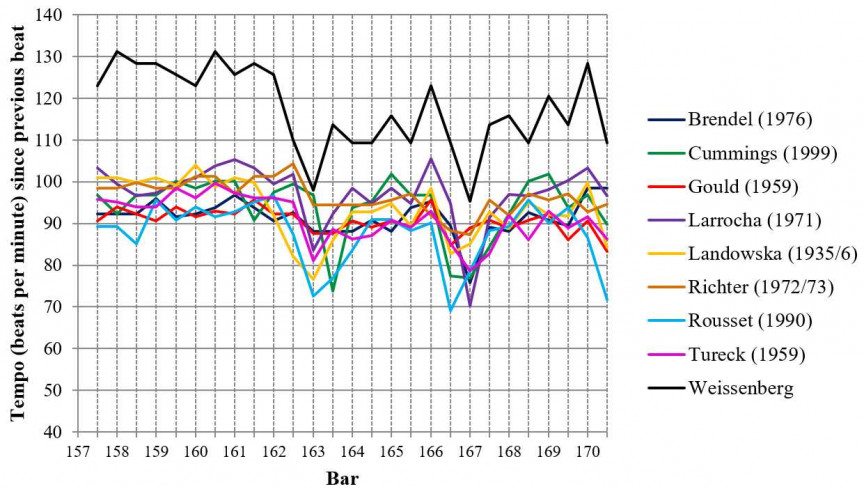
Taking a look firstly at the point in the graph where the theme returns—the ritornello at bar 163—there is, as in the Prelude, a unanimous drop in tempo (Fig. 4 again shows the tempo in crotchets). There is thus an agreement as to the “what” question: what feature or moment in the score to emphasise. All performances, to varying degrees, slow down during the previous beat; Weissenberg, Rousset and Landowska begin to broaden from the beginning of the previous bar. Cummings’s graph dips significantly on the second beat after very little preparation, unlike the other performances.
While Richter, Gould and Brendel maintain the slower tempo in which they have arrived, all other performances (except Cummings) regain a faster speed by the second beat. But the general tendency, as the graph shows, is to slightly drop the average tempo after arriving at the return of the theme. The moment of arrival is further emphasised in Tureck’s and Brendel’s performances by rolling the left-hand chord on the downbeat of bar 163. The harpsichordists Rousset and Cummings roll the chord too, but while this is a standard expressive technique for their instrument, on the piano the effect of the rolled chord is more marked, especially when combined with a subito forte on the downbeat as in Tureck’s case. Marking the moment can involve other techniques: Brendel and Larrocha crescendo into that downbeat, and Richter changes the articulation to a less detached touch for the theme.
There is another point in this graph that dips no less than at the arrival of the ritornello: bar 166, where there is a crotchet rest following a cadential 6/4, after which the theme is reiterated up a fifth. Because no note is struck on the second beat of bar 166, the exact timing at which I tapped that (silent) “beat” into Sonic Visualiser, and consequently what the “tempo” at that point is shown to be in the graph, was dependent on the manner in which the first two quavers of that bar were played in the respective performances; and it was, to an extent, a decision on my part as the listener as to where I felt the beat. Rousset and Cummings, for instance, broaden the first quaver (the 6/4) to last longer, which in my mind pushed back the arrival of the second beat; they then move into the next bar without much more delay (particularly Rousset). Landowska also takes more time on the first quaver relative to the crotchet rest. Larrocha does the opposite, hanging in the rest for longer than her cadential 6/4 had warranted. The effect, though, in all cases, is one of emphasis on the half cadence which sets up a sense of expectation for the next entry. But the answer to the “how” question—the manner in which the moment is emphasised—varies from performance to performance. The fact that this point in the music involves, in most cases, an even greater drop in tempo than at bar 163, suggests there is a significance to the silence: it is as though with the gap in the sound the performer is set more free—allowed to be less metronomical—for a moment. It leads me to think of Bohlman’s third type of aporia: “an area of impossibility and unknowability, of silence and emptiness” (quoted above). If this is what is felt by performers, it might indeed be indicative that the performer’s freedom thrives most between the notes.
Chopin, Polonaise in A flat major, Op. 53

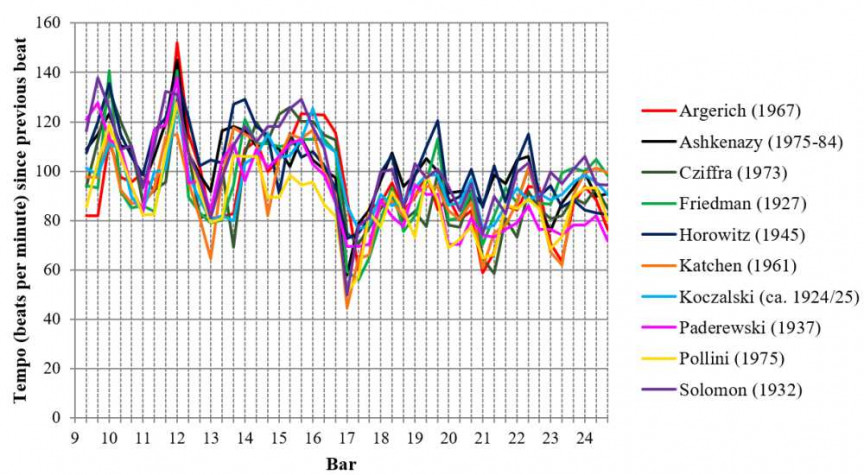
After the more gentle contours of the two Bach examples, this Chopin graph (not altogether unexpectedly) gives the impression of a jagged mountain range, an untamed wilderness of tempo fluctuation (Fig. 5). There is a remarkable consensus in the placement of peaks and troughs. The area with the least consensus is around bar 14 to bar 17: precisely the lead-up to the entry of the theme, at bar 17. Extracting two or three performances at a time shows this more clearly. Fig. 6 shows the graphs of Argerich, Cziffra and Pollini.
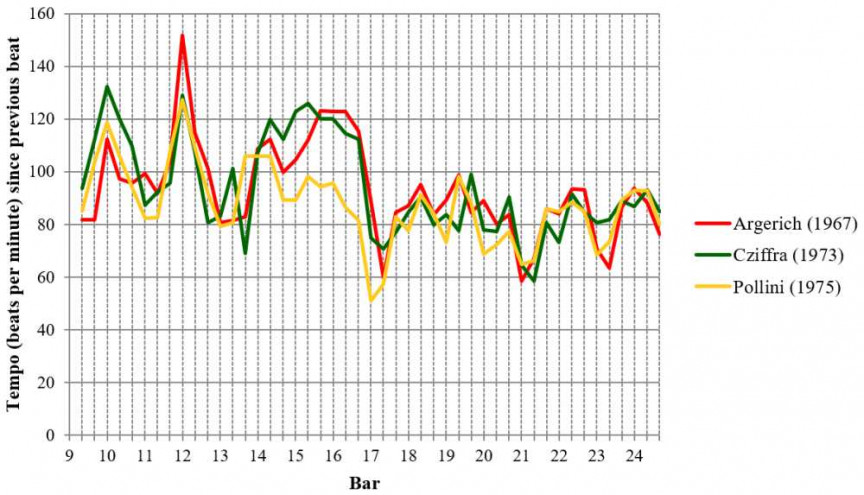
While the squiggles representing the three performances are relatively close together for most of the excerpt, their paths split from around the downbeat of bar 14; Argerich and Cziffra come together by bar 16 but there is a distance between them and Pollini’s slower tempo until the second beat of bar 17. Pollini begins to regain a faster tempo within the first beat of the theme, whereas Argerich’s greater momentum on the approach seems to require further application of the brakes up to the second beat. Cziffra’s accelerando, taking off earlier than most other performances, his diminuendo into bar 17, and the sense of beginning there at a relaxed and certainly new character, marks the moment in a very different way from Argerich’s precipitous tumbling into the theme, which upon arrival resolutely bounces off a drawn-out downbeat. The tension built through Pollini’s lead-up by his very resistance to accelerating, on the other hand, has a grandeur to it, and the crash with which the theme enters on the downbeat of bar 17 is really something. If nodes are points of convergence, the region between bars 14 and 17 in this graph is exactly the opposite—an antinode.
Likewise, the graphs of Horowitz and Solomon (Fig. 7) are least aligned from bar 13 to bar 17, both also further differing at that point from the three performances in Fig. 4. Solomon, having wound up the speed and tension through bar 15, profoundly broadens bar 16 (particularly the third beat), after which the theme enters: immediately down to business in a quick tempo, and with an almost nonchalant lightness considering the huge preparation. Horowitz’s bar 16 has a true sense of expansion, his broadening of tempo coupled with a crescendo into the entry of the theme. The right-hand notes pompously arrive later than the bass on the downbeat of bar 17, giving (together with the overdotted rhythms) the character of the theme an aristocratic zing.
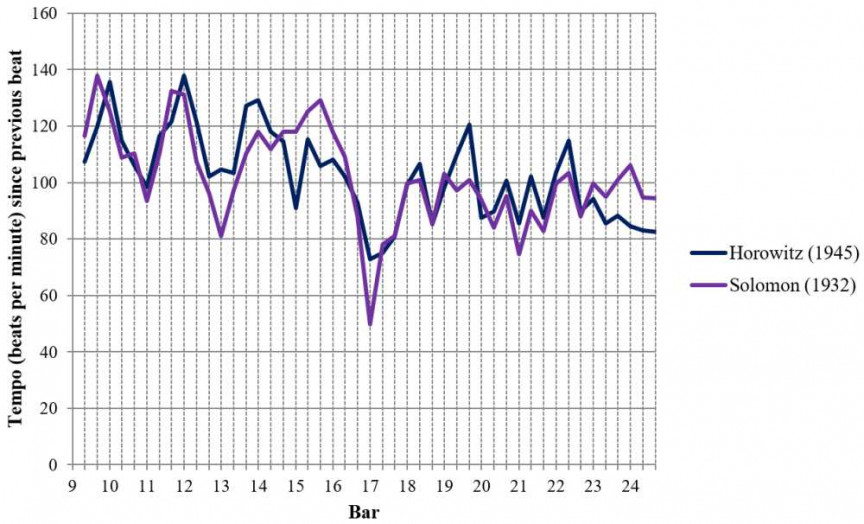
The existence of these “antinodes” is simply intriguing. The shapes of the graphs are obviously not decided in advance: they arise from nothing other than the tempi of the particular performances (existence precedes essence), and the presence of the antinodes only become apparent as such when the graphs of two or more performances come together. The antinode can be said to have been caused by an event in the work—in this case, the lead-up to the theme. A moment determined by the music thus becomes a site for a greater degree of individuality and freedom in tempo than elsewhere. It is the same as in the Bach examples: while the notion that there is a sense of necessity for the performer to bring out certain structural moments of a piece may seem constricting, these performances of the Polonaise suggest the opposite, that the performer’s individuality and perhaps spontaneity are unleashed precisely at such moments (see the Perahia quote in epigraph above).
Chopin, Waltz in D flat major, Op. 64 No. 1
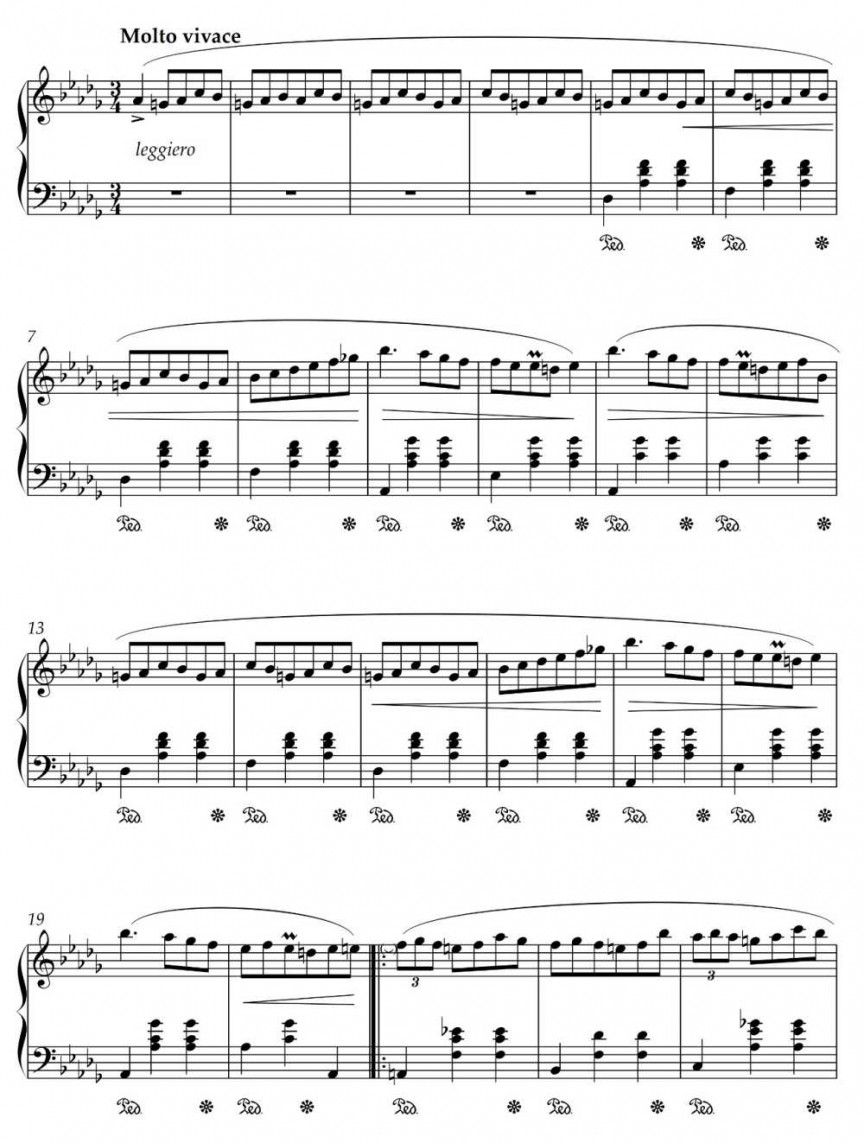
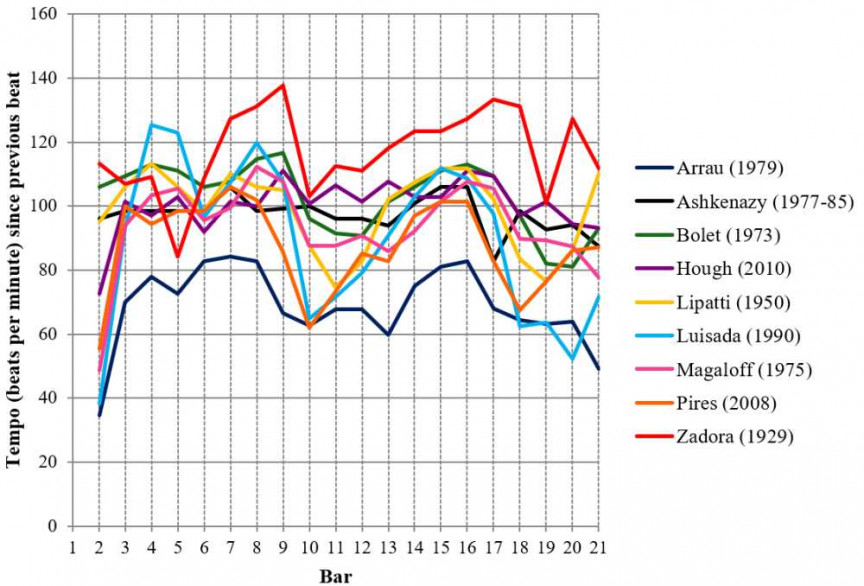
Here, the majority of the performances make a point of the entrance of the theme at bar 5 by either slowing down into it or relaxing the immediate aftermath of the entry, though in most cases very subtly (Fig. 8). Arrau and Zadora14 put the brakes on exclusively during bar 4; Luisada, Bolet and Lipatti broaden bars 4 and 5; Magaloff and Hough broaden bar 5. Pires and Ashkenazy, on the other hand, play through this moment with minimal or no tempo fluctuation. Fig. 8 in general shows less interpretative consensus than was seen in the previous examples. Upon closer scrutiny, though, it becomes evident that there are two more points in the excerpt where the performances tend to drop in tempo. This is especially clear in the graphs of Luisada, Lipatti and Pires (Fig. 9).15
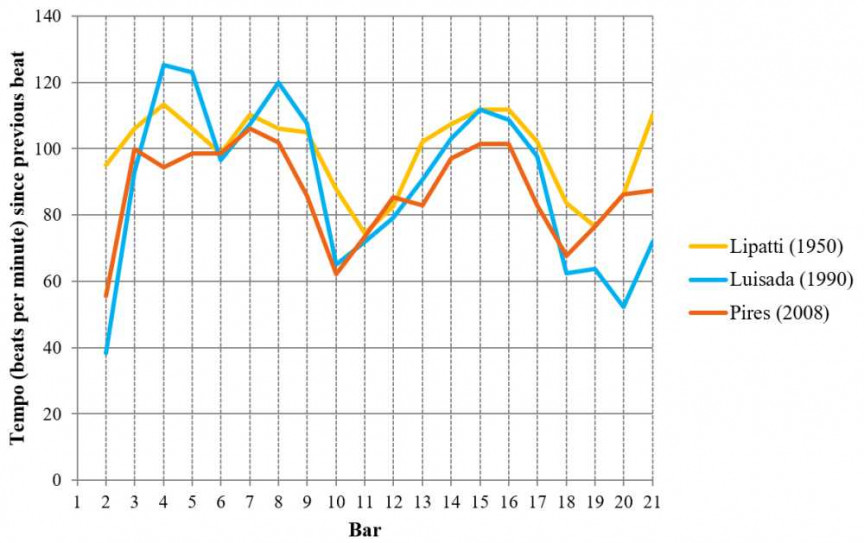
The first of these troughs (bar 10) immediately follows the melodic apex (B flat) coinciding with dominant harmony being heard for the first time in the piece at bar 9 (reiterated in bar 11), and the second trough (from around bar 18) is the corresponding point in the repeat of the melody, with the right hand’s high B flats at bars 17 and 19.
Returning to Fig. 8, some performances slow down into bars 9 and 17, and most linger on the B flats in those bars. Ashkenazy plays through the first two apexes more or less in tempo, and broadens into the one at bar 17 (with an elegant diminuendo) but does not particularly linger on the B flat. Hough resists the lingering almost altogether: his fluctuations are more or less imperceptible when listening. Luisada, in contrast, takes a veritable coffee break at each melodic peak, and the relaxing effect is particularly pronounced because of the fast speed he takes elsewhere.
In addition to the harmonic/melodic event at these points, there is a marking in the score which is potentially significant: a set of hairpins growing into and out of the downbeat of bar 9 (a crescendo hairpin over bars 5-8, and two-bar diminuendo hairpins in bars 9-10 and 11-12 respectively). While hairpins are usually taught today as a direction for an increase or decrease in volume, David Hyun-Su Kim (2012, p. 46) argues that they are better understood, at least in nineteenth-century practice, “not [as] dynamic markings, but rather [as] connotative expressive indications that are frequently associated with rhythmic inflection.” According to Kim,
Early recordings by inner members of the Brahms (and Schumann) circle indicate that hairpin markings were performed with an array of techniques, including dynamics, chord-rolling, hand-displacement, vibrato, portamento, and especially agogic inflections (p. 56).
He identifies four “major hairpin types”, one of which seems to fit the present Chopin example like a glove: “lingering (hairpin pairs, especially in lyrical passages, calling for lingering at the expressive peak)” (p. 56).
It is not possible to assert from my evidence either that the “Brahmsian hairpin” described by Kim was used by Chopin himself in the same way, or that the performances I have selected tend to linger at that moment because of the presence of the hairpin. What can be said is that in these recordings the hairpins are effectively treated in a manner very similar to the way in which Brahms’s circle seems to have treated them: they mark a moment that is particularly expressive or meaningful. Perhaps this melodic apex is another musical threshold, the space between some kind of growth and decay. Many of the performances certainly render this moment in the music “a zone of difference, of fullness”—characteristics of Bohlman’s second type of aporia, quoted above.
The combination of the melodic apex and the switch to dominant harmony after a prolonged tonic has in effect invited the performers to generally take greater liberties in tempo fluctuation than at the commencement proper of the theme at bar 5. Yet, as in Arrau’s or Zadora’s performances, slowing down noticeably into or during bar 5 are possibilities. In such performances, the dance begins at bar 5 with the entry of the waltzing left hand. The comparatively wide variety in interpretations of this passage relative to the other three examples immediately gives rise to two conclusions: firstly, that some pieces (such as this Waltz) seem to attract greater interpretative individuality than others, and secondly, that being performed very often (as this piece is) does not necessarily crystallise the way in which a piece is interpreted. At the same time, there are certain hotspots around which performances tend to slow down, and these places do correspond with identifiable events (thematic, harmonic, etc.) in the score.
Here I would like to introduce Lawrence Kramer’s idea of “hermeneutic windows”, a term coined for usage in music analysis. These windows are places in a work that are marked by signposts involving “harmonic, rhythmic, linear, and formal strategies,” from which “we can…go on to interpret musical meaning” (Kramer 1990, p. 9). I suggest that this concept provides an analogy for pianists’ interpretative acts. “Interpretation”, Kramer writes (still speaking about analysts’ interpretation rather than performers’), “takes flight from breaking points…on the one hand, a gap, a lack, a missing connection; on the other, a surplus of pattern, an extra repetition, an excessive connection” (p. 12). What is relevant to the present context is the idea of seeking out identifiable or marked events. Identifiable features in the score, such as a sudden unexpected harmony or the entry of a theme, become not only points of emphasis in a performer’s interpretation but also sites for individuality and expressiveness. Borrowing Kramer’s language, these points in the music might be called “interpretative windows”. The image of windows calls to mind lift-the-flap picture books or advent calendars, where the flap—the window that opens up to the hidden or the unknown—is not located randomly or arbitrarily. Rather, the hidden world is behind a door, a curtain, inside a treasure chest—at a surprising turn of a musical phrase, a sudden modulation, a longed-for cadence, a cadence gone wrong. And here there is a mutual dependence between performance and work: it is up to the former to open a window, reveal a new world at a cadence, while it is the latter that provides that cadence.
What the graphs tell us about musical works
Three main types of events in scores seemed to attract tempo fluctuation in my analysis: firstly, the moments leading up to and immediately following the arrival of a theme; secondly, in the Waltz, where the harmony changes and the dominant chord sounds for the first time, coinciding with the melodic apex (and the subsequent repetitions of this pattern); and last, but not least, silences in the Polonaise and the Italian Concerto. The first type was my starting point; I had selected these excerpts because they were boundary areas that moved from non-thematic into thematic material. I had expected that most performances would fluctuate in tempo at these points. Yet that expectation was not exclusively rooted in the score, for I had of course heard—and played—these pieces many times in the past.
On the other hand, while I did not set out to consider or to find out about rests, the excerpts that I analysed suggest that silences are important moments in the push-and-pull between the work, score and performer. The opening of the Polonaise, a passage full of rests separating chords and ascending figures, and the crotchet rest in the Italian Concerto at the end of the fourth bar of the ritornello theme, are examples that show how performances stretch metronomic time at moments of silence. The relative magnitude of the ups and downs in the graphs of both these examples show the rests to be no less significant than the moments of thematic appearance themselves in being sites firstly of tempo fluctuation and secondly of difference between performances (this latter point applies particularly to the Italian Concerto). It is as though at points of silence the work loosens its grip on the performance: we witness as much temporal freedom during rests as at any points of structural significance in the score.
The presence of similarities between performances does not contradict the fact that there are no less important differences between performance styles. The moments that I have identified are in fact the very places where performances tend to differ from each other most. While these moments are on the one hand seemingly binding beyond generational and national differences, and in a way obligate the performer to respond in some fashion, at the same time they become sites both for deviation from a steady or average tempo and divergence between performances. In other words, an agreement regarding the “what” question—what moments to emphasise—is coexistent with different ways of answering the “how” question—how to emphasise those moments. Thus, the moments for the greatest freedom, arbitrariness and creativity are found in spots seemingly determined by the score.
I believe that the tendency for pianists from a variety of generations and nationalities to mark the same moments by tempo deviations shows there is something, which we call “the music” or “the work”, that dictates certain interpretative decisions. Fashion or tradition are not the only factors that shape performances. It is perhaps worth mentioning that the degree of freedom available differs between a pianist performing a solo piece and, say, a string player in a symphony orchestra; chamber music allows for a mixture of constraint and freedom that differs again. But these differences are all, in a way, dictated by the particular work, by its specification of factors such as instrumentation, interaction between musicians’ parts, or moments such as solos or cadenzas that allow for—nay, “demand”—greater individual decision-making, perhaps exaggerated freedom. More importantly, the meaningfulness of the work as music (for instance its harmonic meaningfulness, which might create a crucial moment in the structure) would apply beyond piano playing to pieces written for other instruments. Then, if we are to understand how performances of precomposed music operate, it would be counterproductive to avoid talking about works on the grounds that they are abstractions, for they are there—we “interact” with them—when we perform.
Or rather, they are only there when we perform them. Daniel Tate (2012, p. 97) writes: “the artwork is only truly ‘there’ in its performance”.16 So are the “moments” I have been looking at: they are dependent on the performance. It is thus that the work and the performance are absolutely interdependent, as my cyclic model shows. A performance emphasises the lead-up to and appearance of a theme. The importance of that moment therefore in one sense arises from the emphasis in the performance. At the same time, it clearly is the work that tells the performer that the theme appears at that particular point, and becomes the basis for the emphasis.
Conclusions
The cyclic model of the work and the performance, and the nature of freedom and constriction involved in performing a work as seen in the preceding analysis, lead us to a number of conclusions. First, these aspects of the work-performance relationship require us to acknowledge that we cannot ignore the idea of the musical work in relation to classical piano performance and performers. The pianist, performing a work, at least during the act of that particular performance is committed to a “relationship” with the work, in order to unleash its musical potential.
Second, it means that when we talk about works, we are talking about specific performances. We are talking about a specific performer (or ensemble), instrument(s), venue, date, even our own mood, reactions, emotions—a real-life event, and importantly, experience.
Third, the tension resulting from the interdependence of work and performance, the tension between fidelity to the work (constraint) and creativity of the performer (freedom), far from unwelcome, may well be the very thing that sustains the world of classical piano performance. It is normal to hear a pianist saying something like “I’d love to hear so-and-so’s Polonaise-fantaisie,” (note the formulation: [performer]’s [work composed by another person]) to another pianist. Your commitment to the work, your servitude (to use Arrau’s language) as an interpreter, has been rewarded in this formulation: your interpretation makes it your work! This doubleness of dedication and owning, and of constraint and freedom, defines pianistic interpretation, and its tension fuels the performance-work cycle.
Finally, the cycle based on Fichte’s model for self-consciousness shows the extent to which the musical work is a process. It can only become as the performance proceeds. Talking about the completion of a work (“is it complete once it’s notated or only after its first performance?”) forgets the sounding work’s essence as becoming. This may serve as a reminder to performers that in the midst of a performance, the next bar, the next phrase, the next movement, is not yet there. It is a liberating and terrifying thought: the performer is in the position of power to play with the audience’s and their own expectations in the moment; to know that they are literally making the music there and then.
The strength of the cyclical model is that it accounts for the uniqueness of musical (time-bound) works, as opposed to plastic works of art.17 The process of creating a sculpture, for example, does indeed involve a reciprocal relationship. The sculpture is moulded according to the artist’s ideas, and these ideas are in turn affected by the character and quality of the stone, metal or plaster, and by the sculpture’s shape itself as it comes into being—just as Parmer wrote about performances of musical works. But once created, the artist is released from such a relationship with the sculpture; the relationship becomes a uni-directional one in which the artist created the sculpture (past tense forever)—a single arrow pointing from the former to the latter. It is the same with composers and their musical works. But when the musical work is passed on to the performer, the cycle comes alive again, every single time he or she plays the work.
My account does not by any means reflect all that goes on in the performer’s mind during a performance; interpretative decisions (planned or spontaneous, or at times more like accidental) may be contingent upon an infinite number of variables. But my discussion has been purposely limited to the performer’s relationship with the work, in order to shed light on the status of the latter.
The danger of taking the work as an already-existing entity is that it becomes so easy to perform it as though tracing the tracks already trodden countless times in the past. Alfred Brendel (1999, p. 17) mused that
One of the crosses the artist has to bear is that the date of a recording is so rarely indicated on the record sleeve… The artist should have the right to identify his work with a certain phase of his development. It is only the continuous renewal of his vision…that can keep his music-making young.
Herein lies the need for continuously deconstructing the work-concept, that is, resisting its ossification and even questioning its value-in-itself, so that it may be reconstructed in each performance. To conclude I once again call on Murray Perahia: he will now deconstruct none other than the performance—the concept of the great performance-of-a-work.
…there are marvelous recordings, wonderful performances on record. What’s wonderful about them is not even so much the realization of a great piece—though that might be wonderful—it’s the experience of great music making in, let’s say, solo recordings of Cortot, Thibaud, Casals on Bach, or Rachmaninoff’s work. It’s the inspiration of the moment that catches one, not so much even the idea that this is a great performance worked out greatly. It’s a wonderful feeling, while you’re going through it, so it’s wonderful music making! That, I think, is what one tries to capture (Duffie, 1997).
Notes
- This paper is based on my Masters dissertation titled “The pianist’s freedom and the work’s constrictions: what tempo fluctuation in Bach and Chopin indicate” (Sydney Conservatorium of Music, 2017), in particular the second half of it: analysis of pianists’ recordings, and a theoretical discussion of the musical work’s ontology. I wish to thank my supervisor David Larkin for his support and numerous suggestions, as well as the two anonymous reviewers of this paper for their helpful comments.
- Here, technology will come to my aid: as Nicholas Cook (2014, p. 146) has written, “Programs such as Sonic Visualiser mean that the close listening approach…is now musicologically viable in the way that has traditionally been the case of scores but not of recordings.”
- On the other hand, the very history of the work-concept is, arguably, incurably composer-oriented (Talbot ed. 2000, p. 172).
- The notion of “performance” as I use it here includes performers’ learning, rehearsing and savouring processes of the work (at the piano as well as away from it!) in addition to the performance that is publicly presented on stage or in the recording studio. While the present article explicitly analyses only the latter, the conclusions drawn do not exclude the former. Nevertheless a more specific exploration of the offstage “relationship” between performer and work would no doubt be a fascinating and illuminating future project.
- They also cite Horacio Vaggione’s description of the compositional process as an “action/perception feedback loop”.
- I thank Dalia Nassar for introducing me to the work of Fichte.
- The question may arise as to whether the word “musical work” inside the rectangle in this diagram should not be replaced by “score”, if the entire rectangle is supposed to represent the musical work. My intention, however, is to emphasise the absolute inseparability and interdependence of the work and the performance, as the performance of the work unfolds. The score itself, on the other hand, is materially independent of a performance; the performance brings into being the work, not the score.
- Of course, we should not forget that the “poietic” and the “esthesic” in Fig. 2 (i.e. composer and audience) each include both poietic and esthesic processes in their own respective ways, as Frisk and Östersjö and Daniel Tate have pointed out.
- I do not think that each playing-back of a work from a recording can be called a “performance” in itself, especially from the performer’s perspective (for whom a performance involves commitment and labour). Rather, it is the playing-back of a performance that takes place when we listen to a recording of a work. But for the listener, the performance-work cycle takes off only as they listen: the work comes into being during this playing-back of the performance.
- In the particular context of my analysis, I do not treat recordings (heavily edited or not) as fundamentally different from live performance regarding what they tell us about the performance-work relationship. This is because each recording stands as a performance—a realisation—of the work: each recording presents a concrete way in which the work can be brought into being.
- A number of studies have analysed pianists’ use of rubato in recordings to uncover distinctions between different performance styles (Peres Da Costa 2011; Cook 2014). Performance analysis in general has increased dramatically in the past couple of decades (Fabian 2015, p. 25), some using Sonic Visualiser as a tool (for instance Leech-Wilkinson 2015). These studies have mostly contributed to knowledge of “psychological processes” or “stylistic considerations” (Fabian, p. 42), or to a deeper understanding of historical and social issues (Cook 2014), rather than feeding directly into a discussion of the musical work.
- Measuring every quaver would show even more fluctuation in some performances: Jarrett, for instance, often draws out the first two semiquavers and goes quicker through the second half of the crotchet beat.
- The content of this paragraph is the result of a discussion with Nigel Fabb, to whom I am grateful for sharing with me his ideas on liminality in music.
- Zadora’s performance alters the introduction: the four-bar right-hand filigree written out by Chopin is extended to eight bars, and a long (about eight bars) trill is added before that. (The graph therefore shows the tempi for the music that correspond to the bar numbers in the score.)
- I would like to point out in passing the antinode in Fig. 9 between bars 3 and 6.
- There is at least a subtle difference between what Tate and I are talking about, since his discussion embraces the artwork in general, while I am trying to consider the uniqueness of the time- and sound-bound musical work. What is in common is the commitment demanded of the person experiencing—“performing”—the work.
- This model may also serve to illuminate an actor’s experience of performing a theatrical work (also time-bound). The difference between verbal language and musical “language”, and the different cultures and sets of ideals within the respective worlds of acting and of classical music, among other factors, may result in two slightly different kinds of work-performance “cycles”.
